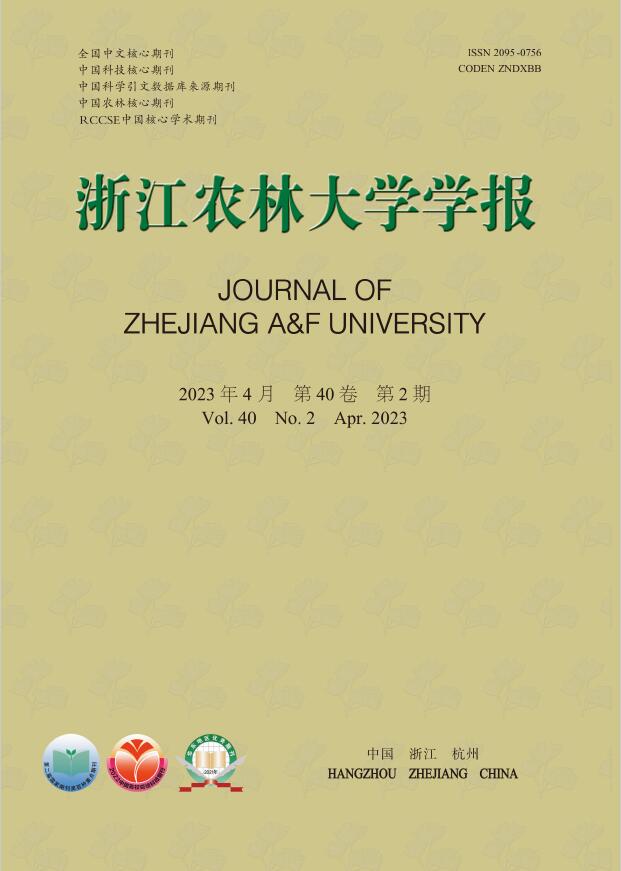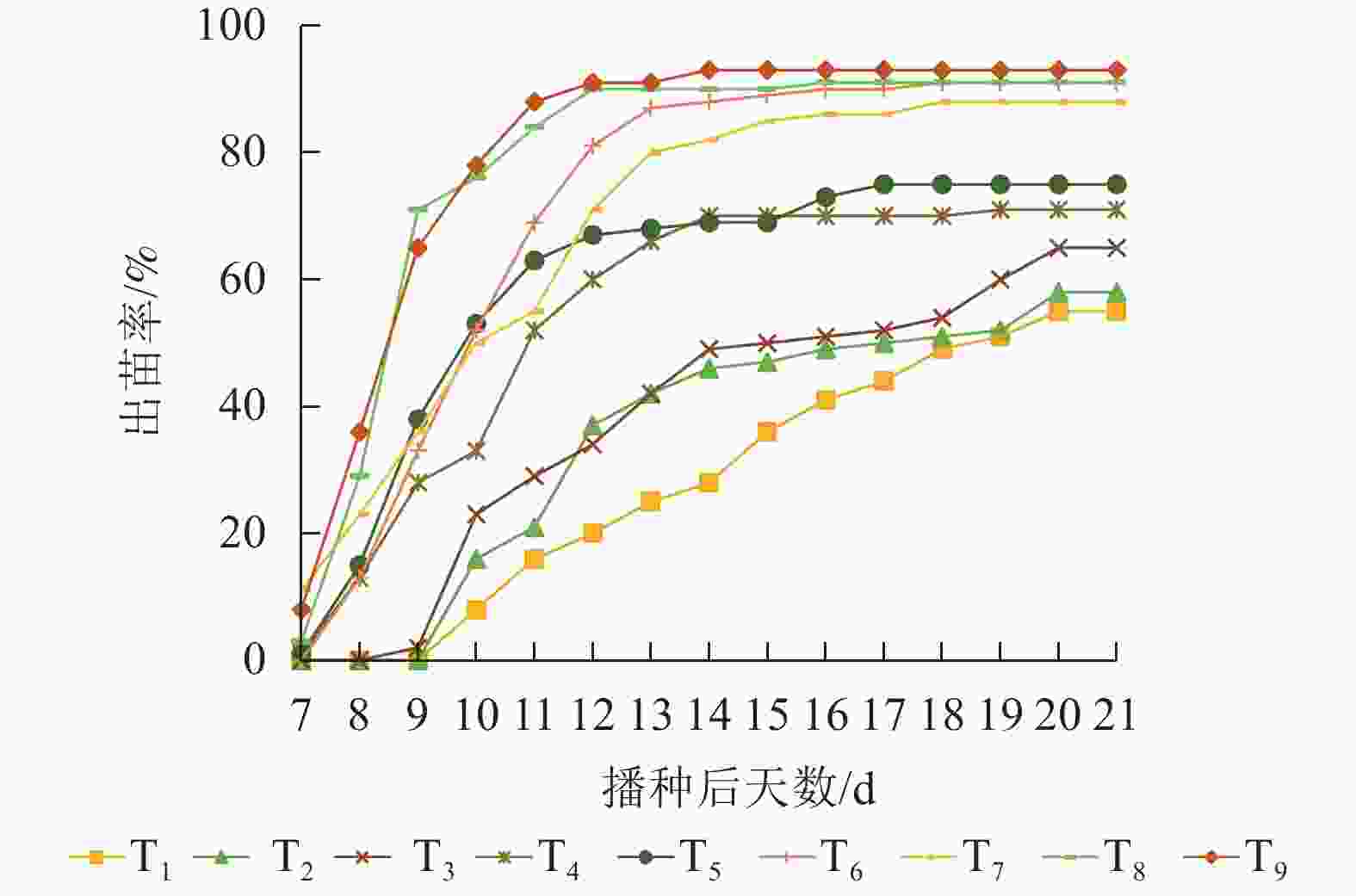-
现代农业中无土育苗技术的广泛应用,极大促进了种苗工厂化的发展。泥炭作为无土育苗的重要基质来源,具有质轻、透气、保水保肥能力强等多种优良特性,但其价格昂贵且不可再生,因此亟需寻找可替代泥炭的生态型育苗基质[1]。园林废弃物堆肥产品作为一种廉价易得的育苗基质,富含有机质和其他营养成分,可有效替代泥炭用于基质育苗[2]。但其容重较大,pH、电导率较高,营养元素不均衡[3−4],并且如果在育苗基质中高比例添加园林废弃物堆肥产品,可能会导致植物生长矮小、叶片黄化、出苗率低、品质差或产生“烧苗”现象[5−6],因此需要对园林废弃物堆肥产品进行改良和优化[7−8]。
腐熟花生Arachis hypogaea壳质地较轻,营养元素丰富,将其作为基质组分可有效降低基质容重,增加基质通气性和持水性,提高基质肥力[9]。朱巧莲等[10]将腐熟花生壳替代泥炭用作金线莲Anoectochilus roxburghii的栽培基质后发现:腐熟花生壳可显著降低基质容重,增加其持水量和非毛管孔隙度,提高其全氮含量;梁新安等[11]将腐熟花生壳替代草炭用作黄瓜Cucumis sativus的育苗基质后发现:添加适当比例腐熟花生壳可有效提高基质总孔隙度,改善其理化性质,增加其保水保肥性。腐植酸作为一种重要的基质改良剂,可有效改善基质物理结构,增加其养分[12]。刘宇锋等[13]将腐植酸添加至床垫料用作辣椒Capsicum annuum的栽培基质后发现:适当比例腐植酸的添加可显著降低基质容重,提高其总孔隙度和通气孔隙度,有效改善其品质;顾鑫等[14]将腐植酸施入土壤用于玉米Zea mays种植后发现:适当比例腐植酸的施用可有效降低土壤盐碱特性,提高土壤肥力,达到良好的改良效果。因此,腐熟花生壳和腐植酸的协同作用是否可用作改良园林废弃物堆肥产品,使其可高效替代泥炭进行植物育苗值得研究。
紫苏Perilla frutescens为唇形科Labiatae的1年生草本植物,含有多种活性成分,具有较高的药用、食用和文化价值[15]。紫苏叶、根和种子是天然营养物质的有效来源,含有丰富的酚类化合物,具有良好的抗过敏、抗中毒和抗肿瘤作用[16],因此,有关紫苏育苗的研究也逐渐成为热点。但是,将园林废弃物堆肥产品作为泥炭替代基质用于紫苏无土育苗的研究相对较少。本研究利用腐熟花生壳和腐植酸改良园林废弃物堆肥产品,并将其用于紫苏育苗。通过温室育苗试验,探讨不同处理的育苗基质对紫苏出苗的影响,以期筛选出适合紫苏育苗的最优育苗基质,为园林废弃物资源化再利用和药用植物紫苏的育苗基质开发探索新途径。
-
紫苏种子购于北京林业大学科技股份有限公司。供试园林废弃物堆肥产品来源于植物园堆肥厂,采用好氧堆肥法堆置。堆肥前,将园林废弃物粉碎至2 cm,调节含水量为60%,添加尿素调节碳氮比为25%~30%,并加入0.5 mg·kg−1自制菌剂(主要成分为枯草芽孢杆菌Bacillus subtilis、乳酸菌和放线菌);堆肥过程中隔7 d翻堆1次,并定期定量洒水,使堆体含水率维持约60%,堆肥周期为45 d。堆置后的园林废弃物堆肥产品质地疏松、无结块、无明显异臭味和可视杂物, pH为7.89,电导率为1.99 mS·cm−1,质量分数全氮为17.73 g·kg−1,全磷为4.46 g·kg−1,全钾为3.14 g·kg−1,铵态氮为714.09 mg·kg−1,硝态氮为129.58 mg·kg−1,速效磷为4 764.97 mg·kg−1,速效钾为627.76 mg·kg−1,符合GB/T 33891—2017《绿化用有机基质》的产品质量要求。
供试用改良剂腐熟花生壳、腐植酸均购于北京林业大学科技股份有限公司。腐熟花生壳使用前粉碎,过2 mm筛。其pH为6.8,电导率为1.51 mS·cm−1,质量分数全氮为26.9 g·kg−1,全磷为13.22 g·kg−1,全钾为3.84 g·kg−1,铵态氮为1 256.85 mg·kg−1,硝态氮为207.00 mg·kg−1,速效磷为9 601.65 mg·kg−1,速效钾为765.84 mg·kg−1。腐植酸为黑色粉末状,粒径为0.125~1.000 mm。其pH为5.6,电导率为0.95 mS·cm−1,质量分数腐植酸为700.00 g·kg−1,黄腐酸为200.00 g·kg−1,全氮为10.29 g·kg−1,全磷为11.39 g·kg−1,全钾为3.63 g·kg−1,铵态氮为536.80 mg·kg−1,硝态氮为92.74 mg·kg−1,速效磷为3 927.41 mg·kg−1,速效钾为604.59 mg·kg−1。
-
本次育苗试验在北京林业大学科技股份有限公司温室苗圃进行。按表1设计,在园林废弃物堆肥产品中添加腐熟花生壳和腐植酸。共设9个育苗基质处理,每处理重复10盆。
处理 不同育苗基质的原材料组成/% 处理 不同育苗基质的原材料组成/% 处理 不同育苗基质的原材料组成/% 腐熟花生壳(干质量) 腐植酸(干质量) 腐熟花生壳(干质量) 腐植酸(干质量) 腐熟花生壳(干质量) 腐植酸(干质量) T1 0 0 T4 1.5 0 T7 3.0 0 T2 0 3.0 T5 1.5 3.0 T8 3.0 3.0 T3 0 6.0 T6 1.5 6.0 T9 3.0 6.0 Table 1. Orthogonal experimental design
-
根据表1所示:分别将添加了9种不同质量分数腐熟花生壳和腐植酸的园林废弃物堆肥产品置于210 mm×150 mm×185 mm的塑料花盆(基质表面距花盆顶部约3 cm),拌入质量比为0.1%的多菌灵,杀菌消毒后,灌水至饱和,置于温室稳定3 d,备用。在制备基质的同时,采集样品。
-
选取颗粒饱满、大小一致的紫苏种子,均匀播种于花盆,每粒种子埋于距基质表面1 cm处,每盆播种3粒,并对基质充足灌水。播种至幼苗发芽期间,始终保持基质湿润。
-
播种后,每天观察出苗情况,统计出苗数,计算紫苏在21 d内的出苗率。紫苏播种后第40天统计其幼苗株数(紫苏在出苗后可能发生死亡现象,因此,紫苏在播种后第21天的出苗株数和第40天的出苗株数并不完全一致)、幼苗叶片数、被虫(小菜蛾Plutella xylostella)咬食叶片数和被虫咬食株数,计算其单株叶片数、死亡率、受虫害叶片率和受虫害株率。出苗率=(种子出苗数/供试种子粒数)×100%,受虫害叶片率=(被虫咬食叶片数/叶片总数)×100%,受虫害株率=(被虫咬食株数/总株数)×100%,死亡率=(死亡数/总株数)×100%。
-
参照ZHANG等[8]和鲍士旦[17]的方法,测定育苗基质的容重、最大含水量、总孔隙度、通气孔隙、持水孔隙、水气比、pH、电导率以及全氮、全磷、全钾、铵态氮、硝态氮、速效磷、速效钾和有机质质量分数等。其中:容重、最大含水量、总孔隙度、通气孔隙、持水孔隙、水气比等指标用环刀法测定;pH用pH 400防水型笔式pH计(上海仪电科学仪器股份有限公司)测定;电导率用EC 400防水型笔式电导率/TDS/盐度计(上海仪电科学仪器股份有限公司)测定;全氮用H2SO4-H2O2消煮,凯氏定氮法(K1306型全自动凯氏定氮仪,上海晟声自动化分析仪器有限公司)测定;全磷用H2SO4-H2O2消煮,钼锑抗比色法(752型紫外光栅分光光度计,上海元析仪器有限公司)测定;全钾用H2SO4-H2O2消煮,火焰光度计法(FP640型火焰光度计,上海精密科学仪器有限公司)测定;铵态氮用2 mol·L−1KCl浸提,靛酚蓝比色法测定;硝态氮用酚二磺酸比色法测定;速效磷用NaHCO3浸提-钼锑抗比色法测定;速效钾用NH4OAc浸提,火焰光度法测定;有机质用稀释热法测定。
-
采用Excel 2019和SPSS 23.0软件进行数据处理与单因素方差分析;采用CANOCO 5.0分析紫苏育苗与育苗基质理化性质的关系;采用模糊数学的隶属函数法综合评价紫苏在不同处理基质的育苗情况。具体计算方法为[2]:①若某指标与紫苏育苗呈正相关,则用公式R(xi)=(xi−xmin)/(xmax−xmin)求其隶属函数值。其中:xi为某指标测定值,xmax、xmin分别为该指标的最大值和最小值,R(xi)为指标xi的隶属函数值;②若某指标与紫苏育苗呈负相关,则用公式R(xi)=1−(xi−xmin)/(xmax−xmin)求其隶属函数值。③将各指标的隶属函数值进行累加后求其平均值,即为紫苏幼苗的综合评价指数。值越大,说明紫苏育苗效果越好,育苗基质越适宜。
-
由表2可知:与T1相比,添加腐熟花生壳和腐植酸的基质(T2~T9)容重显著(P<0.05)降低,分别降低了11.49%、13.54%、14.80%、17.36%、18.21%、22.38%、32.57%、24.27%;最大含水量显著(P<0.05)增加,分别增加了6.13%、6.12%、11.81%、17.62%、18.31%、22.71%、29.56%、24.56%;总孔隙度显著(P<0.05)增加,分别增加了3.42%、11.82%、15.64%、17.58%、23.25%、25.48%、31.65%、25.86%;通气孔隙度显著(P<0.05)增加,分别增加了23.43%、21.12%、52.07%、53.15%、34.49%、122.27%、124.04%、88.33%;持水孔隙度显著(P<0.05)增加,分别增加了0.22%、10.34%、9.81%、11.89%、21.45%、9.99%、16.86%、15.87%;水气比降低但不显著,分别降低了18.82%、8.92%、27.81%、26.96%、9.71%、50.52%、47.85%、38.49%。
处理 容重/(g·cm−3) 最大含水量/% 总孔隙度/% 通气孔隙度/% 持水孔隙度/% 水气比/% T1 0.44±0.02 a 64.59±0.72 g 62.92±0.08 e 8.68±0.04 d 54.24±0.14 e 6.25±0.06 a T2 0.39±0.03 b 68.55±1.09 f 65.07±0.09 e 10.71±0.03 c 54.36±0.13 e 5.07±0.07 a T3 0.38±0.05 b 68.54±1.11 f 70.36±0.10 d 10.51±0.05 c 59.85±0.12 c 5.69±0.04 a T4 0.37±0.04 b 72.22±0.11 e 72.76±0.11 c 13.20±0.03 b 59.56±0.09 d 4.51±0.02 a T5 0.36±0.01 b 75.97±1.14 d 73.98±0.13 c 13.29±0.09 b 60.69±0.18 b 4.57±0.02 a T6 0.36±0.03 b 76.42±1.08 c 77.55±0.10 b 11.67±0.08 c 65.87±0.20 a 5.64±0.07 a T7 0.34±0.06 c 79.26±0.65 b 78.95±0.09 b 19.29±0.11 a 59.66±0.32 d 3.09±0.04 a T8 0.30±0.02 e 83.68±0.54 a 82.83±0.06 a 19.45±0.10 a 63.39±0.18 a 3.26±0.02 a T9 0.33±0.02 d 80.45±0.45 b 79.19±0.06 b 16.35±0.14 a 62.85±0.21 a 3.84±0.07 a 理想范围 <0.40[8] 70.00~85.00[8] 70.00~90.00[8] 10.00~30.00[18] 45.00~−65.00[18] 2.00~4.00[19] 说明:同列不同小写字母表示不同处理间差异显著 (P<0.05) Table 2. Physical properties of different substrates
-
由表3可知:与T1相比,添加腐熟花生壳和腐植酸的基质(T2~T9) pH显著(P<0.05)降低,分别降低了1.77%、3.30%、3.93%、5.32%、7.22%、8.62%、9.63%、11.53%;电导率显著(P<0.05)降低,分别降低了13.57%、20.10%、23.12%、24.12%、25.63%、23.62%、26.13%、30.15%;全氮质量分数显著(P<0.05)增加,分别增加了1.07%、0.73%、14.44%、13.25%、11.73%、30.34%、28.82%、25.83%;全磷质量分数显著(P<0.05)增加,分别增加了38.34%、31.83%、41.48%、23.77%、23.54%、63.90%、65.47%、60.09%;全钾质量分数无显著变化;铵态氮质量分数显著(P<0.05)增加,分别增加了12.62%、0.94%、28.84%、50.53%、48.09%、85.52%、85.53%、85.59%;硝态氮质量分数显著(P<0.05)增加,分别增加了0.08%、9.71%、16.86%、14.63%、3.89%、11.06%、27.54%、6.53%;除T3外,其他处理的速效磷质量分数显著(P<0.05)增加,T2、T4、T5、T6、T7、T8、T9分别增加了1.54%、6.82%、18.13%、10.03%、22.15%、31.45%、20.27%;速效钾质量分数显著(P<0.05)增加,分别增加了1.51%、1.90%、1.86%、2.06%、2.80%、0.60%、0.99%、3.05%;有机质质量分数显著(P<0.05)增加,分别增加了0.05%、0.17%、13.26%、12.77%、13.09%、22.66%、23.24%、22.73%。
处理 pH 电导率/(mS·cm−1) 全氮/(g·kg−1) 全磷/(g·kg−1) 全钾/(g·kg−1) T1 7.89±0.08 a 1.99±0.74 a 17.73±0.68 e 4.46±1.07 b 3.14±0.04 a T2 7.75±0.12 a 1.72±0.14 a 17.92±1.54 e 6.17±1.25 a 3.20±0.03 a T3 7.63±0.02 a 1.59±0.12 b 17.86±2.11 e 5.88±0.45 a 3.45±0.27 a T4 7.58±0.10 a 1.53±0.03 b 20.29±1.38 c 6.31±1.00 a 3.16±0.06 a T5 7.47±0.08 b 1.51±0.06 b 20.08±3.10 c 5.52±0.45 a 3.27±0.03 a T6 7.32±0.04 c 1.48±0.05 b 19.81±1.14 d 5.51±1.03 a 3.19±0.14 a T7 7.21±0.05 d 1.52±0.08 b 23.11±2.03 a 7.31±0.75 a 3.38±0.09 a T8 7.13±0.09 e 1.47±0.02 b 22.84±1.98 a 7.38±0.96 a 3.34±0.11 a T9 6.98±0.06 f 1.39±0.01 c 22.31±2.87 b 7.14±0.42 a 3.51±0.19 a 处理 铵态氮/(mg·kg−1) 硝态氮/(mg·kg−1) 速效磷/(mg·kg−1) 速效钾/(mg·kg−1) 有机质/(mg·kg−1) T1 714.09±44.38 d 129.58±5.24 c 4 764.97±82.52 e 627.76±3.24 d 548.69±12.91 f T2 804.24±62.78 c 129.69±0.93 c 4 838.35±130.58 d 637.22±2.24 b 548.98±14.93 f T3 720.83±111.33 d 142.16±8.82 b 4 690.12±175.35 e 639.70±1.25 a 549.65±18.31 f T4 920.03±28.44 b 151.43±17.54 a 5 090.17±168.04 c 639.44±7.95 a 621.43±9.22 d T5 1074.94±32.49 b 148.54±2.33 a 5 628.76±202.95 b 640.71±2.23 a 618.78±9.37 e T6 1 057.53±173.67 b 134.62±18.06 b 5 242.77±45.47 c 645.31±0.25 a 620.52±11.54 d T7 1 324.80±115.38 a 143.91±5.24 b 5 820.21±331.18 b 631.53±8.20 c 673.02±15.90 c T8 1 324.87±85.48 a 165.26±4.36 a 6 263.58±89.33 a 633.95±1.50 c 676.22±8.56 b T9 1 325.27±28.26 a 138.04±3.55 b 5 730.77±117.63 b 646.93±3.00 a 673.43±18.88 c 说明:同列不同小写字母表示不同处理间差异显著 (P<0.05) Table 3. Chemical properties of different substrates
-
由图1可知:T4、T5、T7、T8、T9紫苏种子在播种后第7天开始出苗,T6在播种后第8天开始出苗,T3在播种后第9天开始出苗,T1和T2在播种后第10天开始出苗。其中,T8和T9紫苏种子出苗速度较快,并且在播种后第11天出苗率已达80%以上,分别为84%和88%;T1和T2紫苏种子出苗速度较慢,在播种后第21天出苗率仍均不足60%,分别为55%和58%。在播种后的第21天,紫苏在不同基质内的出苗率从高到低依次为T9、T8和T6、T7、T5、T4、T3、T2、T1,其中T6~T9的出苗率大于80%,分别为91%、88%、91%、93%,T1~T5的出苗率小于80%,分别为55%、58%、65%、71%、75%。
由表4可知:不同基质的紫苏幼苗单株叶片数、幼苗死亡率、幼苗受虫害叶片率和幼苗受虫害株率有显著(P<0.05)差异。其中,T8和T9紫苏幼苗单株叶片数较多,T3和T4紫苏幼苗单株叶片数较少;T1和T2紫苏幼苗死亡率较高,T8和T9紫苏死亡率较低;T1和T6紫苏幼苗受虫害叶片率较高,T3和T5紫苏幼苗受虫害叶片率较低;T5和T6紫苏幼苗受虫害株率较高,T3和T8紫苏幼苗受虫害株率较低。
处理 单株叶片数/片 死亡率/% 受虫害叶片率/% 受虫害株率/% T1 5.40±1.51 b 36.12±1.44 a 12.46±0.43 b 19.54±0.76 e T2 5.37±1.03 b 33.17±2.63 b 8.56±0.58 f 19.43±0.31 e T3 4.21±1.57 d 22.89±2.63 d 6.99±0.89 h 18.57±0.99 f T4 4.46±0.50 d 21.30±1.88 e 11.83±0.54 c 21.78±0.76 c T5 4.50±2.22 d 32.20±1.64 c 7.43±1.11 g 23.84±1.98 b T6 5.03±0.81 c 14.31±0.92 f 17.73±1.02 a 26.46±1.53 a T7 4.82±1.31 c 12.67±2.75 g 10.84±0.98 d 23.72±0.92 b T8 6.12±0.59 a 10.74±1.75 i 9.93±0.47 e 17.65±0.83 g T9 6.43±0.62 a 11.34±2.42 h 11.95±0.87 c 20.68±0.54 d 说明:同列不同小写字母表示不同处理间差异显著 (P<0.05) Table 4. Number of leaves per plant, mortality rate, leaf infestation rate and plant infestation rate of P. frutescens seedlings in different substrates
-
冗余分析结果显示:多个理化性质间存在共线性,因此选用向前选择法筛选出方差膨胀因子小于10的容重、总孔隙度、pH、电导率以及全氮、全磷、全钾、速效钾质量分数等8个理化性质作为解释变量。图2为紫苏育苗情况与筛选后基质理化性质间的冗余分析排序图。在基质理化性质中,容重、pH、电导率、总孔隙度和全氮质量分数对紫苏育苗情况有较高的解释量;紫苏幼苗出苗率、受虫害叶片率和受虫害株率与育苗基质总孔隙度以及全氮、全磷、全钾、速效钾质量分数呈正相关,与育苗基pH、电导率、容重呈负相关;紫苏幼苗单株叶片数与育苗基质全氮、全磷、全钾质量分数以及总孔隙度呈正相关,与育苗基质pH、容重呈负相关,与育苗基质速效钾质量分数、电导率相关性较弱;紫苏幼苗死亡率与育苗基质pH、电导率、容重呈正相关,与育苗基质总孔隙度以及全氮、全磷、全钾、速效钾质量分数呈负相关。
-
通过模糊数学的隶属函数法,计算T1~T9基质的紫苏育苗综合评价指数。由表5可知:T2~T9的紫苏幼苗综合评价指数均高于T1,其中T8的紫苏幼苗综合评价指数最高,表明T8的紫苏育苗效果最优。
处理 单指标评价指数 综合评
价指数出苗率 单株叶
片数死亡率 受虫害
叶片率受虫害
株率T1 0.00 0.54 0.00 0.49 0.79 0.36 T2 0.08 0.52 0.12 0.85 0.85 0.48 T3 0.26 0.00 0.52 1.00 0.92 0.54 T4 0.42 0.11 0.58 0.55 0.65 0.46 T5 0.53 0.13 0.15 0.96 0.48 0.45 T6 0.95 0.37 0.86 0.00 0.25 0.49 T7 0.87 0.27 0.92 0.64 0.49 0.64 T8 0.95 0.86 1.00 0.73 1.00 0.91 T9 1.00 1.00 0.98 0.54 0.74 0.85 Table 5. Comprehensive evaluation of P. frutescens seedlings on different substrates
-
除T1 (100%园林废弃物堆肥产品)外,T2~T9的容重均小于0.40 g·cm−3,表明腐熟花生壳和腐植酸可以降低基质紧实度,使其更为疏松透气。这与已有研究结果[10−12]一致。在一定范围内,孔隙度越大,基质容纳的空气和水分越多,基质的排水能力和保水能力就越好[20]。添加适宜比例腐熟花生壳和腐植酸可显著增加基质的含水量和孔隙度,改善基质中大、小孔隙的比例,从而改善园林废弃物堆肥产品的保水性和通气性,使其处于理想范围。其主要原因可能是由于腐熟花生壳质地疏松,具有较大的孔隙,腐植酸含羧基、羟基等亲水基团,可促进基质中水稳性大团聚体的形成,减少微团聚体的含量,因此将两者结合可降低基质容重,提高基质水分供给和气体交换能力,从而起到保水保肥作用[8, 21]。
-
理想基质的pH为6.0~7.5[7]。未添加腐熟花生壳和腐植酸的园林废弃物堆肥产品(T1)的pH大于7.5,呈碱性,不利于种子萌发和幼苗生长;添加腐熟花生壳和腐植酸后(T2~T9),基质环境变成中性,达到理想要求。这可能是因为腐熟花生壳和腐植酸中含有较多羧基、酚羟基等酸性基团可解离出较多的H+,可与园林废弃物堆肥产品中的碱性物质发生中和反应,使基质的pH下降[21, 22]。这表明腐熟花生壳和腐植酸作为改良剂可有效调节园林废弃物堆肥产品的pH,使基质酸碱环境可达理想范围。
理想育苗基质的电导率应小于0.65 mS·cm−1(GB/T 33891—2017)。本研究中,T1~T9的电导率均不在理想范围,但是腐熟花生壳和腐植酸的添加可降低基质可溶性盐的含量,其主要原因可能是由于腐熟花生壳和腐植酸中含有较多的酚羟基,此类官能团上的H+可与基质水溶液的K+、Na+等盐基离子发生离子交换作用,减少基质水溶液的可溶性盐含量,达到降低基质电导率的效果[23]。
腐熟花生壳和腐植酸的添加可提高基质中铵态氮和硝态氮质量分数,主要原因可能是由于腐植酸可提高脲酶活性,促进尿素分解,还可与尿素分解产生的NH4+结合生成稳定的腐植酸铵盐,避免了氨的挥发,增加了NH4+质量分数;腐熟花生壳含有丰富的纤维素,质地坚硬,疏松多孔,利于硝化细菌附着或将其作为固体碳源进行利用,从而提高了硝化细菌的活性,增加了NO3−质量分数[24−25]。因此,将腐熟花生壳和腐植酸作为改良剂添加至园林废弃物堆肥产品中,可增强基质供应氮元素的能力,有助于植物对基质养分的吸收。
添加腐熟花生壳和腐植酸可提高基质中全磷和速效磷质量分数,主要原因可能是由于腐熟花生壳和腐植酸自身含有较多的磷素,且腐熟花生壳疏松多孔的结构适合微生物生长,又可为其提供所需的碳源,增强微生物活动和数量,两者的添加可显著加速有机磷向无机磷的转化。另外,腐植酸含有的胡敏酸可与基质的铁、铝等金属发生络合反应,减缓磷的固定;腐植酸含有的酸性基团还可活化基质的无机固定态磷[23]。因此,将两者联合添加可提高基质的全磷和速效磷质量分数,增强基质供应磷素的能力。
添加腐植酸可在一定程度上增强基质供应速效钾的能力,可能是由于腐植酸粉末具有巨大的表面积,带有大量的电荷,可与基质的K+进行吸附交换作用,补充基质溶液的钾质量分数,从而增加基质的钾利用率[14, 23]。
添加腐熟花生壳和腐植酸可以有效增加基质的有机质供应,主要原因可能是由于腐熟花生壳含大量的纤维素、半纤维素和木质素等含碳有机化合物和蛋白质等含氮化合物,同时,腐植酸也是一种大分子有机物质,有机质丰富,将两者联合添加可有效增加基质肥力,提高有机质供应水平[14]。
-
种子的出苗率和出苗速度是衡量育苗基质优劣的重要指标,其中种子出苗率达80%是判断基质适宜的首要依据[2, 7, 26]。本研究表明:紫苏种子在T6~T9的出苗率达80%,出苗情况较好。可能是由于T6~T9的基质容重、pH、电导率等较低,总孔隙度以及全氮、全磷、全钾、速效钾质量分数等较高,可为紫苏种子提供合适的水分、氧气、温度和养分,比较适合紫苏种子出苗。
叶片数量是影响生态系统服务的植物功能性状之一,可反映植株的生长情况[27]。本研究表明:T8和T9的紫苏生长发育较好,可生长出更多的叶片进行光合作用和蒸腾作用,可能是由于T8和T9的容重和pH较低,总孔隙度以及全氮、全磷、全钾质量分数等较高,其通气性较好且供肥能力较强,可提供给幼苗更多的养分,利于幼苗生长和叶片建成。
本研究表明:紫苏幼苗死亡率受总孔隙度、容重、pH、电导率以及全氮、全磷、全钾、速效钾质量分数的影响较大,且随基质容重、pH、电导率的增加而增加,随基质总孔隙度以及全氮、全磷、全钾、速效钾质量分数的增加而减少。T6~T9的紫苏幼苗死亡比例较低,可能是由于T6~T9的基质容重、pH、电导率较低,总孔隙度以及全氮、全磷、全钾、速效钾质量分数较高,可为紫苏提供良好的基质环境,比较适合紫苏幼苗成活。
T8的紫苏幼苗虫害发生率较低,抗虫性较好,可能是由于T8的养分质量分数较高,酸碱性适宜,可溶性盐质量分数较低,不仅可为紫苏幼苗提供充足的合成次生代谢产物等防御性物质所需的原料,使其加强化学防御,提高其对害虫直接或间接的防御能力,也可以为其提供适宜的基质环境,增加其营养和根系活力,进而增强紫苏幼苗对害虫的耐受性,提高其抗虫性。
-
添加腐熟花生壳和腐植酸可显著降低园林废弃物堆肥产品的容重、pH、电导率,提高其最大含水量和孔隙度,增加其全氮、全磷、铵态氮、硝态氮、速效磷、速效钾和有机质质量分数。表明腐熟花生壳和腐植酸可使园林废弃物堆肥产品质量得到一定程度的提高。改良后的园林废弃物堆肥产品可显著提高紫苏幼苗发芽率和发芽速度,降低幼苗死亡率和虫害发生率,提高抗虫性,有利于紫苏快速出苗和成活,同时具有一定的生物防治效果。在9种不同基质中,紫苏幼苗综合效果由高向低依次为T8、T9、T7、T3、T6、T2、T4、T5、T1,表明T8 (即3.0%腐熟花生壳+3.0%腐植酸)为最优组配。这一组配不仅可以改善园林废弃物堆肥产品的理化性质,增加养分质量分数,还可以提高紫苏出苗率,降低幼苗受虫害程度。
Effect of green waste compost combined decomposed peanut shells and humic acid on seedling emergence of Perilla frutescens
doi: 10.11833/j.issn.2095-0756.20220292
- Received Date: 2022-04-11
- Accepted Date: 2022-11-20
- Rev Recd Date: 2022-11-17
- Available Online: 2023-04-03
- Publish Date: 2023-04-20
-
Key words:
- green waste compost products /
- decomposed peanut shell /
- humic acid /
- Perilla frutescens /
- seedling emergence
Abstract:
| Citation: | SONG Tianyu, ZHANG Lu. Effect of green waste compost combined decomposed peanut shells and humic acid on seedling emergence of Perilla frutescens[J]. Journal of Zhejiang A&F University, 2023, 40(2): 304-313. DOI: 10.11833/j.issn.2095-0756.20220292 |












 DownLoad:
DownLoad:
